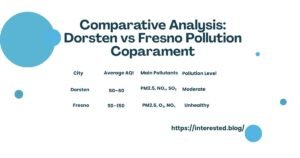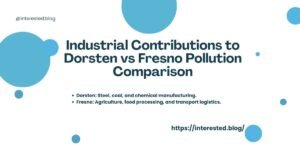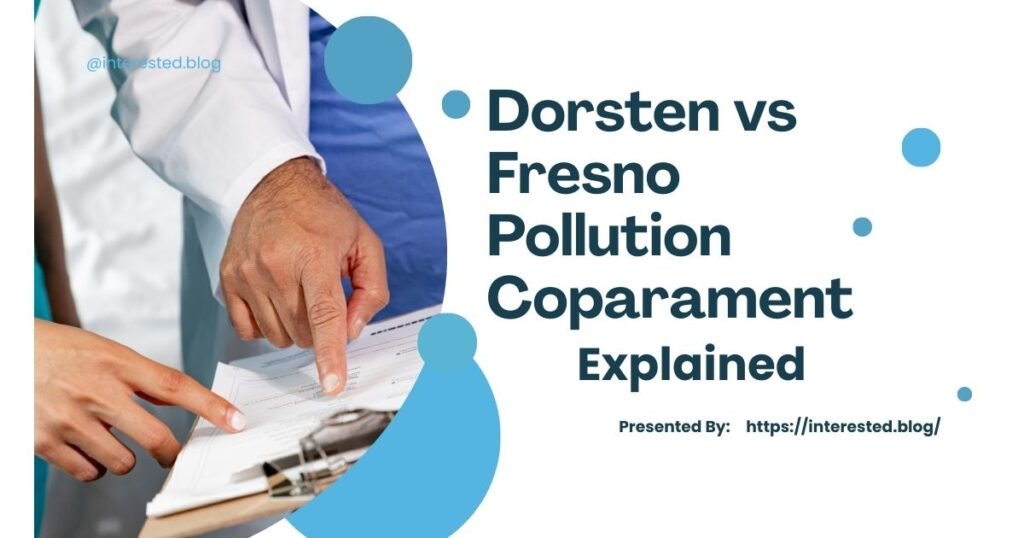Introduction
When we think of pollution, images of smog-filled cities and industrial wastelands often come to mind. But pollution isn’t just about what we see; it’s about what we breathe, drink, and live with daily. In this article, we explore Dorsten vs Fresno Pollution Coparament, analyzing how these two cities differ in their environmental challenges and health impacts.
At first glance, Dorsten, Germany, and Fresno, California, might seem worlds apart—one in Europe, the other in the heart of the United States. Yet both face unique pollution issues that affect residents’ quality of life. Understanding Dorsten vs Fresno Pollution Coparament allows us to examine the broader effects of industrialization, urbanization, and agricultural practices on air and water quality.
The Origins of Pollution Concerns in Dorsten and Fresno
Dorsten’s industrial history, centered around coal mining and steel production, has left a lasting environmental footprint. Meanwhile, Fresno’s urbanization, heavily tied to agriculture and transportation, contributes to airborne pollutants like PM2.5 and ozone. Studying Dorsten vs Fresno Pollution Coparament highlights these differing pollution origins.
Early Signs of Environmental Degradation
Legacy industrial activities in Dorsten have led to soil and water contamination. Fresno faces challenges from agricultural runoff, vehicle emissions, and its valley geography, which traps pollutants. Both cities’ experiences are crucial in understanding Dorsten vs Fresno Pollution Coparament.
Role of Transportation and Energy Sectors
Both cities’ transportation sectors contribute significantly to their pollution profiles. In Dorsten, the reliance on coal and gas for energy production has implications for air quality. Fresno’s extensive freeway system and high vehicle density exacerbate its pollution levels, particularly during peak traffic times.
Key Pollutants in Dorsten vs Fresno Pollution Coparament
- Airborne Particulates (PM2.5 & PM10): Dorsten’s industrial emissions and heating systems elevate PM levels, while Fresno’s agriculture and wildfire smoke contribute to spikes.
- Nitrogen Oxides, Sulfur Dioxide, and Ozone: Both cities experience these pollutants, but Fresno’s ozone levels are particularly high in summer.
- Heavy Metals and Chemical Runoff: Dorsten’s soil shows traces of lead and cadmium, whereas Fresno’s fertilizers and pesticides enter water systems, illustrating the differences in Dorsten vs Fresno Pollution Coparament.
Measuring Pollution: How Data is Collected
Both cities have established air quality monitoring networks. In Dorsten, stations are managed by local environmental agencies, providing real-time data on pollutants. Fresno’s monitoring is conducted by the San Joaquin Valley Air Pollution Control District, offering insights into regional air quality trends.
Satellite Imagery and Remote Sensing
Satellite technology allows for comprehensive monitoring of air quality over large areas. Both cities benefit from satellite data to assess pollution levels and identify sources.
Citizen Science and Community-Led Initiatives
Community involvement plays a crucial role in pollution monitoring. In Dorsten, local groups participate in environmental monitoring projects. Fresno residents engage in initiatives like the Community Air Protection Program to address localized pollution issues.
Dorsten Pollution Profile: Current Status and Trends
As of recent reports, Dorsten’s AQI falls within the “Good” to “Moderate” range, indicating relatively clean air. However, occasional spikes in PM2.5 levels are observed, especially during winter heating periods.
Industrial Hotspots Contributing to Pollution
Former industrial zones in Dorsten continue to impact local air and water quality. Efforts are underway to rehabilitate these areas and reduce pollution levels.
Seasonal Variations in Dorsten’s Pollution Levels
Pollution levels in Dorsten exhibit seasonal variations, with higher PM concentrations during colder months due to increased heating demands and atmospheric conditions that trap pollutants.
Fresno Pollution Profile: Current Status and Trends
Fresno’s AQI has fluctuated over the years, often reaching “Unhealthy” levels during summer months due to high ozone concentrations and wildfire smoke.
Agricultural and Vehicular Contributions to Pollution
Agricultural activities contribute to Fresno’s pollution through dust, pesticide use, and fertilizer runoff. Vehicular emissions further exacerbate air quality issues, particularly in densely populated areas.
Comparing Fresno’s Seasonal Pollution Patterns to Dorsten
While both cities experience seasonal pollution variations, Fresno’s challenges are more pronounced during summer and wildfire seasons, whereas Dorsten’s issues are more evident during winter months.
Comparative Analysis: Dorsten vs Fresno Pollution Coparament

| City | Average AQI | Main Pollutants | Pollution Level |
| Dorsten | 50–60 | PM2.5, NOₓ, SO₂ | Moderate |
| Fresno | 90–150 | PM2.5, O₃, NOₓ | Unhealthy |
This table highlights how Dorsten vs Fresno Pollution Coparament differs in terms of air quality and pollutant types, showing higher exposure risks in Fresno.
Major Pollutants in Each City
Both cities face challenges with PM2.5 and NOₓ. However, Fresno’s ozone levels are notably higher, especially during summer months.
Annual Pollution Exposure Differences
Residents of Fresno are exposed to higher annual pollution levels compared to those in Dorsten, primarily due to agricultural activities and wildfire smoke.
Health Impacts of Pollution in Dorsten vs Fresno
Both cities report cases of asthma and other respiratory illnesses. However, Fresno’s higher pollution levels correlate with increased health issues, particularly among children and the elderly.
Cardiovascular Issues Linked to Air Pollution
Long-term exposure to air pollution in both cities has been associated with cardiovascular problems. Fresno’s residents, facing higher pollution levels, are at greater risk.
Vulnerable Populations: Children, Elderly, and Low-Income Communities
Vulnerable groups in both cities experience disproportionate health impacts. In Fresno, low-income communities are often situated near pollution sources, exacerbating their health risks.
Environmental Consequences of Dorsten vs Fresno Pollution Comparison
Pollution in both cities affects local ecosystems. In Dorsten, industrial runoff impacts aquatic life, while in Fresno, agricultural runoff affects water quality and biodiversity.
Water and Soil Contamination
Both cities face challenges with water and soil contamination. Dorsten’s legacy industrial activities contribute to soil pollution, while Fresno’s agricultural practices lead to water contamination.
Long-Term Climate Implications
Continued pollution in both cities contributes to climate change, with implications for weather patterns, agriculture, and public health.
Economic Implications of Dorsten vs Fresno Pollution Coparament
Pollution impacts both health and the economy.
- Healthcare Costs: Higher pollution in Fresno leads to greater medical expenses from respiratory and cardiovascular conditions, compared to moderate costs in Dorsten.
- Productivity Losses: Air pollution reduces workforce efficiency. Dorsten sees minor dips, while Fresno experiences frequent absenteeism.
- Property Values and Urban Planning: Pollution depresses property values, especially in Fresno neighborhoods near farms or highways, while Dorsten’s policies help maintain real estate stability.
Government Policies and Regulations in Dorsten
Dorsten benefits from Germany’s stringent environmental laws, including emissions limits and mandatory reporting for industries. Local authorities enforce these regulations rigorously, ensuring industrial compliance and environmental protection.
Initiatives to Reduce Industrial Emissions
Programs targeting energy efficiency, cleaner production methods, and sustainable urban planning have helped Dorsten reduce industrial emissions significantly over the past decade.
Effectiveness of Air Quality Management Programs
Air quality management programs in Dorsten, such as monitoring networks and public awareness campaigns, have shown measurable improvements in pollution levels, particularly for PM2.5 and NOₓ.
Government Policies and Regulations in Fresno
California enforces strict environmental regulations, but Fresno faces challenges in compliance due to its agricultural and vehicular emissions. The San Joaquin Valley Air Pollution Control District implements programs aimed at reducing ozone and particulate matter.
Environmental Justice Programs for Affected Communities
Fresno has implemented environmental justice initiatives to protect vulnerable communities disproportionately affected by pollution. These programs include grants, air monitoring, and community engagement projects.
Analysis of Policy Success and Gaps
While progress has been made, Fresno’s pollution levels remain high. Challenges include enforcement difficulties, agricultural contributions, and geographic factors that trap pollutants.
Community Action and Public Awareness
Local communities play a pivotal role in pollution control. In Dorsten, environmental groups advocate for green spaces and sustainable practices. Fresno residents organize clean air campaigns and participate in monitoring initiatives.
Public Campaigns and Educational Programs
Both cities promote environmental education in schools and through public campaigns. Raising awareness helps residents understand pollution risks and adopt healthier practices.
Citizen Participation in Pollution Monitoring
Citizen science initiatives, such as air quality sensors and reporting platforms, empower residents to contribute to pollution tracking in both Dorsten and Fresno.
Technological Solutions for Pollution Mitigation
Dorsten and Fresno are increasingly adopting renewable energy sources. Wind, solar, and bioenergy help reduce reliance on fossil fuels, lowering emissions.
Smart City Initiatives and Real-Time Air Monitoring
Technological solutions, including smart sensors and IoT-based air monitoring systems, provide real-time data for proactive pollution management.
Industrial Emission Control Technologies
Industries in Dorsten and Fresno are investing in cleaner technologies such as scrubbers, filters, and catalytic converters to minimize emissions.
Transportation and Urban Planning Strategies
Enhancing public transport reduces vehicle emissions. Dorsten has invested in efficient bus and rail networks, while Fresno promotes carpooling and transit subsidies.
Cycling and Pedestrian-Friendly Infrastructure
Both cities encourage cycling and walking to reduce pollution. Dorsten has extensive bike lanes; Fresno is gradually expanding pedestrian-friendly zones.
Traffic Management to Curb Pollution Levels
Intelligent traffic systems, congestion pricing, and emission zone regulations help manage pollution from vehicular traffic in both cities.
Industrial Contributions to Dorsten vs Fresno Pollution Comparison

- Dorsten: Steel, coal, and chemical manufacturing.
- Fresno: Agriculture, food processing, and transport logistics.
Comparison of Emission Standards and Compliance
Dorsten’s industries adhere to stricter EU regulations, resulting in lower emissions per unit of production. Fresno’s agriculture-driven emissions remain challenging despite state standards.
Role of Industrial Modernization in Pollution Reduction
Modernizing industrial operations in both cities—upgrading machinery, adopting cleaner fuels—has significantly reduced pollution footprints over the last decade.
Agricultural Practices and Their Environmental Impact
Fresno is one of the U.S.’s major agricultural hubs, producing crops like almonds, grapes, and tomatoes. This industry contributes significantly to local air pollution through dust, diesel-powered machinery, and pesticide application.
Use of Fertilizers and Pesticides Affecting Air and Water Quality
Chemical inputs from agriculture lead to nitrate runoff into waterways, soil contamination, and airborne chemical drift, affecting human and ecological health.
Sustainable Farming Practices to Reduce Pollution
Adopting sustainable practices—such as precision farming, integrated pest management, and organic fertilizers—can mitigate Fresno’s environmental impact.
Case Studies: Successful Pollution Reduction Efforts
- Transition to renewable energy in industrial zones
- Expansion of green spaces
- Public campaigns promoting reduced energy consumption
Fresno’s Pilot Programs and Lessons Learned
- Community air monitoring projects
- Incentives for low-emission agricultural equipment
- Public awareness campaigns on wildfire smoke exposure
Comparative Effectiveness of These Interventions
Dorsten’s regulated industrial policies show measurable improvements, whereas Fresno’s efforts are ongoing, constrained by agriculture’s dominant role in pollution.
Future Projections for Dorsten vs Fresno Pollution Comparison
Dorsten is expected to maintain low-to-moderate pollution levels with continued industrial modernization and renewable energy adoption. Fresno may experience fluctuations depending on climate change impacts, agricultural practices, and wildfire frequency.
Potential Technological and Policy Interventions
- Expanding renewable energy usage
- Strengthening environmental regulations
- Encouraging community-based monitoring
Role of Climate Change in Shaping Future Air Quality
Rising temperatures, droughts, and wildfires in Fresno may worsen air quality, while Dorsten may face milder climate-related challenges.
Expert Opinions and Scientific Studies
Recent research highlights that both Dorsten and Fresno face unique pollution challenges but differ in pollutant composition and exposure risks. Studies emphasize the importance of local interventions, public engagement, and technological solutions to improve air quality.
Tips for Residents: Protecting Yourself from Pollution
- Use HEPA filters in homes
- Keep windows closed during high pollution days
- Regularly clean HVAC systems
Personal Protective Measures
- Wear N95 masks during poor air quality days
- Limit outdoor activities during peak pollution periods
Lifestyle Adjustments to Reduce Exposure
- Maintain indoor plants to improve air quality
- Advocate for local green initiatives
- Support low-emission transportation options
Final Thoughts
Comparing Dorsten vs Fresno Pollution Comparison reveals that while Dorsten benefits from stringent industrial regulations and modernization, Fresno faces persistent challenges due to agriculture and geographic constraints. Both cities demonstrate that community engagement, technological innovation, and policy enforcement are critical for improving air quality.Residents and policymakers alike must collaborate to sustain healthy environments and minimize the health and economic impacts of pollution.
Additional Resources and References
- Environmental Protection Agency (EPA) databases
- European Environment Agency reports
- Local government environmental reports
- Contact local environmental organizations for updates and community programs
FAQs:
Q. What is Dorsten vs Fresno Pollution Coparament?
It’s a comparative analysis of pollution levels, health risks, and environmental impacts in Dorsten and Fresno.
Q. How does Dorsten vs Fresno Pollution Coparament affect health?
Fresno residents face higher risks of respiratory and cardiovascular issues, while Dorsten’s pollution poses moderate health concerns.
Q. Are there successful programs in Dorsten vs Fresno Pollution Coparament?
Dorsten uses industrial modernization and green energy initiatives; Fresno employs community monitoring and low-emission agriculture programs.
Q. How can residents mitigate risks from Dorsten vs Fresno Pollution Coparament?
Using home air filters, wearing masks, and following pollution advisories help reduce exposure.
Q. How does climate change influence Dorsten vs Fresno Pollution Coparament?
Wildfires and drought worsen Fresno’s air quality, while Dorsten faces milder climate effects.
Read More Content: Maydidate


